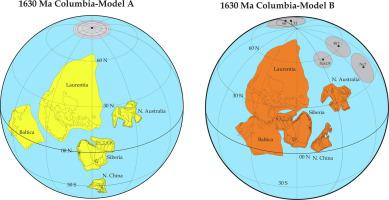Gondwana Research ( IF 7.2 ) Pub Date : 2022-06-30 , DOI: 10.1016/j.gr.2022.06.014 Joseph G. Meert , M. Santosh

|
The proposal that a Paleo-Mesoproterozoic supercontinent, Columbia, preceded the existence of Rodinia was forwarded in 2002. A similar proposal that same year provided a detailed discussion of 2.1–1.8 Ga orogenic belts distributed throughout the globe thought to represent the assembly of Columbia. In the 20 years that followed, evidence in favor of Columbia has grown but its exact configuration and geometrical relationships between various cratons remains elusive. One of several challenges in reconstructing Columbia is the paucity of high-quality paleomagnetic data. Progress is slow, but steady, in this realm as it requires painstaking field and laboratory work to generate a new pole. Despite large gaps in the database, we have generated testable models of Columbia. Unfortunately, there are seldom coeval poles from many continents and reconstructions represent small time-slices in Columbia’s lifespan. In this contribution, we review the history of the Columbia hypothesis, evidence mounted in support of the idea and status of the model. We present a statistical method to evaluate goodness of fit in paleomagnetically based reconstructions where data are separated in both time and space. Baltica and Amazonia are often linked together with eastern Laurentia to form a long-lived accretionary orogenic margin of Columbia. This so-called SAMBA model was originally posited as a one billion year long (1.8–0.8 Ga) fixture in both Columbia and Rodinia. Paleomagnetic data are supportive of this connection from ∼ 1.75–1.5 Ga, but not during younger times. We also test a recent model of Columbia based on the highest quality paleomagnetic poles available at that time. Our analysis reveals numerous discrepancies between data and models that will need to be addressed as work towards reconstructing Columbia continues unabated.
中文翻译:

哥伦比亚超大陆:用于重建的古磁极的回顾、现状和统计评估
2002 年提出了在 Rodinia 存在之前存在古中元古代超大陆哥伦比亚的提议。同年的一项类似提议详细讨论了分布在全球的 2.1-1.8 Ga 造山带,这些造山带被认为代表了哥伦比亚的集合。在随后的 20 年里,支持哥伦比亚的证据越来越多,但它的确切构造和各种克拉通之间的几何关系仍然难以捉摸。重建哥伦比亚的几个挑战之一是缺乏高质量的古地磁数据。在这个领域,进展缓慢但稳定,因为它需要艰苦的实地和实验室工作才能产生新的极点。尽管数据库中存在很大差距,但我们已经生成了可测试的哥伦比亚模型。很遗憾,许多大陆很少有同时代的两极,重建代表了哥伦比亚生命周期中的一小段时间。在这篇文章中,我们回顾了哥伦比亚假设的历史,以及支持该模型的想法和状态的证据。我们提出了一种统计方法来评估基于古地磁的重建的拟合优度,其中数据在时间和空间上都是分开的。波罗的海和亚马逊流域经常与东劳伦西亚相连,形成哥伦比亚的长期增生造山带。这种所谓的 SAMBA 模型最初被认为是哥伦比亚和罗迪尼亚的一个长达 10 亿年(1.8-0.8 Ga)的固定装置。古地磁数据支持从~ 1.75-1.5 Ga 的这种联系,但在更年轻的时期不支持。我们还根据当时可用的最高质量的古磁极测试了哥伦比亚的最新模型。我们的分析揭示了数据和模型之间的许多差异,随着重建哥伦比亚的工作继续有增无减,需要解决这些差异。











































 京公网安备 11010802027423号
京公网安备 11010802027423号